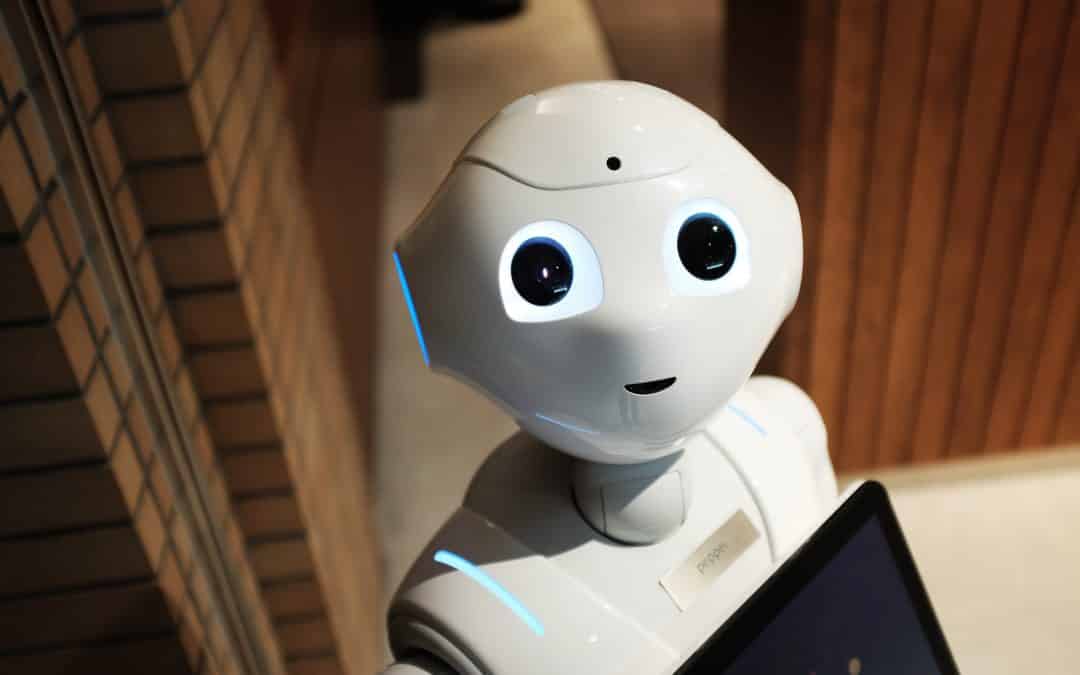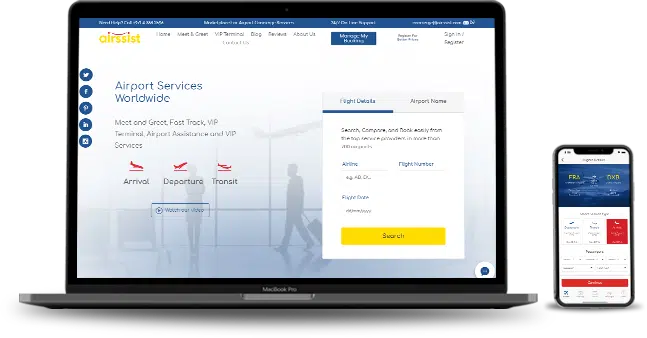Table of Contents
One can envision entering a futuristic airport where the voyage commences with a cordial salutation from a benevolent robotic being. While traversing through the densely populated areas, these marvels propelled by artificial intelligence effortlessly direct you to your designated gate, guaranteeing a seamless and anxiety-free journey. Greetings and welcome to the realm of Airport Robot Assistants, an environment where state-of-the-art Artificial Intelligence (AI) systems are fundamentally altering the operations of airports and reshaping the complete experience of passengers.
Understanding Airport Challenges & How AI Could Help
As airports strive to enhance passenger experiences and improve operational efficiency, they face numerous challenges. Long queues, confusing wayfinding, and security concerns are just a few examples. However, with the advent of Artificial Intelligence (AI), airports now have a powerful tool to overcome these challenges and transform the way they operate.
Greeting Robot in Airports: A Friendly Face in the Crowd
One of the most visible applications of AI in airports is the introduction of Airport Robot Assistant “greeting robots”. These friendly machines are designed to welcome passengers, provide directions, and answer basic inquiries. With their ability to understand multiple languages and their affable demeanor, greeting robots create a positive and welcoming atmosphere for travelers.
Airports and Artificial Intelligence: The Perfect Match
AI has the potential to revolutionize airport operations in various ways. From streamlining security processes to optimizing baggage handling, AI technologies offer innovative solutions to enhance efficiency and improve the overall passenger experience. By leveraging data analytics and machine learning algorithms, airports can make informed decisions and adapt to changing circumstances in real-time.
How AI Can Transform Airport Management
Self-Check-in & Baggage Drop Off: Efficiency at Your Fingertips
AI-based self-check-in kiosks and automated baggage drop-off systems have become increasingly common in airports worldwide. Passengers can now breeze through the check-in process, reducing waiting times and eliminating the need for extensive manual intervention. This not only improves efficiency but also allows airport staff to focus on more critical tasks.
Passenger Flow Management Systems: Smooth Sailing Through the Airport
Managing the flow of passengers is a complex task for airports, especially during peak hours. AI-powered systems can analyze real-time data from various sources, including security checkpoints and boarding gates, to optimize passenger flow. By identifying bottlenecks and suggesting alternative routes, these systems ensure a seamless journey for travelers.
Benefits and Impacts of AI on Airport Management
Enhanced Efficiency: Doing More with Less
AI technologies enable airports to streamline operations, automate repetitive tasks, and optimize resource allocation. This leads to increased efficiency and cost savings, allowing airports to handle higher passenger volumes without compromising service quality.
Improved Passenger Experience: Navigating the Airport Hassle-free
With AI-powered wayfinding systems, passengers can easily navigate through airports, locate facilities, and receive personalized recommendations. Whether it’s finding the nearest coffee shop or the quickest security checkpoint, Airport Robot Assistant enhances the passenger experience by reducing stress and providing tailored assistance.
Challenges and Considerations
While Airport Robot Assistant presents numerous benefits, its implementation in airports also comes with challenges. Privacy concerns, data security, and the need for human oversight are some of the considerations that airport authorities must address. Striking the right balance between automation and human interaction is crucial to ensure a seamless and secure airport experience.
1- Privacy and Data Security
One of the primary concerns surrounding AI implementation in airports is the protection of passenger data and privacy. With the collection and analysis of vast amounts of personal information, airports must prioritize data security and comply with stringent privacy regulations. Safeguarding passenger data and ensuring transparency in data usage are crucial aspects that airport authorities must address to build trust and maintain passenger confidence.
2- Human Oversight and Collaboration
While AI offers automation and efficiency, human oversight and collaboration remain vital in airport operations. It is essential to strike the right balance between AI-driven automation and human interaction, especially in critical areas such as security and passenger assistance. Human personnel play a crucial role in decision-making, handling exceptional situations, and providing a level of empathy and understanding that AI cannot replicate.
3- Ethics and Bias
AI algorithms are only as good as the data they are trained on. It is essential to ensure that the data used to develop AI systems in airports is diverse, representative, and free from biases. Bias in AI algorithms can lead to discriminatory outcomes and unfair treatment of passengers based on factors such as race, gender, or nationality. Careful consideration and ongoing monitoring are required to prevent and mitigate any unintended biases in AI systems deployed in airports.
4- Integration and Scalability
Implementing AI technologies in airports requires careful planning and seamless integration with existing infrastructure and systems. Compatibility issues, technical challenges, and the need for scalability to accommodate increasing passenger volumes are considerations that airport authorities must address. A well-designed implementation strategy, along with robust testing and evaluation, is crucial to ensure the smooth transition and long-term success of AI integration in airports.
5- Public Perception and Acceptance
Introducing AI-powered robots and systems in airports may raise concerns among some passengers who are unfamiliar with the technology or have reservations about its impact on human jobs. Clear communication, public education, and a focus on highlighting the benefits of AI in enhancing safety, efficiency, and passenger experience are essential to gain public acceptance and support.
Future Trends and Innovations
1- Smart Airports: A Connected Ecosystem
The future of AI in airports lies in the concept of smart airports, where various technologies, including AI, IoT, and Big Data, work together to create a connected ecosystem. From real-time flight updates to personalized services, smart airports will redefine the way passengers interact with airport facilities.
2- Biometrics and Facial Recognition
The use of biometrics, such as facial recognition, in airport processes is expected to become more widespread. From seamless check-ins to secure boarding procedures, biometric technologies offer convenience, speed, and enhanced security.
3- Predictive Analytics and Machine Learning
AI-powered predictive analytics and machine learning algorithms will enable airports to anticipate passenger behavior, optimize resource allocation, and proactively manage potential disruptions. This will lead to more efficient operations and improved passenger experiences.
4- Virtual Assistants and Voice Recognition
Virtual assistants equipped with natural language processing and voice recognition capabilities will become integral parts of the airport experience. Passengers will be able to interact with AI-powered virtual assistants for real-time information, personalized recommendations, and assistance throughout their journey.
5- Robotics and AI Collaboration: The Rise of Co-bots
As AI continues to evolve, the integration of Airport Robot Assistant will become more prevalent. Collaborative robots, or co-bots, will work alongside human staff, assisting with tasks such as cleaning, maintenance, and baggage handling. This collaboration between humans and AI-driven robots will optimize operational efficiency and improve service quality.
Read more about How Virtual Reality is Changing the Entertainment Scene at Airports
Popular Robot Greeters Serving in International Airports
Just like human celebrities, some robots are famous, too! These robots have proven success in performing their assigned tasks and have become well-known worldwide, here are the top 4 on the list:
Nao of Tokyo’s Haneda Airport in Japan
Nao is a humanoid robot. It is connected to a digital flight information screen. Nao can have interactive conversations with passengers while answering their queries. Interestingly, Nao also communicates with airport staff via their smart watches to provide them with flight updates so they can assist travelers, as well.
Josie Pepper of Munich Airport in Germany
Pepper employs its artificial intelligence to greet passengers and connect them to the main terminal and shuttle areas. The robot can also generate personalized answers to passengers’ queries.
Spence of the Amsterdam-Schiphol Airport in the Netherlands
Spencer has one main objective at the airport, which is directing travelers from the terminal to their boarding gates and vice versa, smoothly and quickly, depending on the included scanning devices.
Anbot of Shenzhen Airport in China
Anbot is a police robot! It handles guarding patrols, facial recognition, and intelligence services. Anbot analyzes light and sound to detect criminals, it can also chase them at a speed of 18 KM/hour.
Will Robots Replace Humans in Airports Completely?
Robots’ abilities are fascinating but mainly limited to performing simple tasks much quickly and efficiently. However, there is nothing complicated in the process. Here are some tasks that only humans can be fully trusted with:
- When it comes to airport procedures, complexities occur every day, whether in terms of documentation or customer service, such complexities can’t be handled by robots.
- We can all agree that robots can assist in airport security checks, but they can’t handle it completely because each security issue requires a specific behavior that only humans can wisely choose. According to a survey conducted by Travelzoo global company, 67% of travelers believe that the idea of robots handling airport security is risky and frightening.
- Last but not least, people will always need the friendliness and hospitability that only humans can offer to each other and no machine can ever master, no matter how advanced it gets.
FAQs
Is AI replacing human employees in airports?
A: No, AI is not meant to replace human employees but rather to enhance their capabilities and improve efficiency. AI technologies in airports aim to automate mundane tasks, allowing staff to focus on delivering excellent customer service and addressing more complex issues.
How does AI improve airport security?
A: AI enhances airport security by automating screening processes, utilizing biometrics for identity verification, and detecting suspicious behaviors through advanced video analytics. These technologies help identify potential threats more efficiently, ensuring a safer travel experience for passengers.
Will AI impact job opportunities in the airport industry?
A: While AI may redefine certain job roles within the airport industry, it also creates new opportunities for specialized skills. As AI technologies become more prevalent, there will be a growing demand for professionals in data analysis, AI system management, and human-AI collaboration.
Note: Please note that the information on this page is generic & subject to change due to fluctuations in airport services. Kindly confirm service availability with our team, as offerings may vary daily.
 French | Français
French | Français Spanish | Espana
Spanish | Espana German | Deutch
German | Deutch Arabic | العربية
Arabic | العربية Chinese | 中文(简体)
Chinese | 中文(简体)  Japanese | 日本語
Japanese | 日本語 






